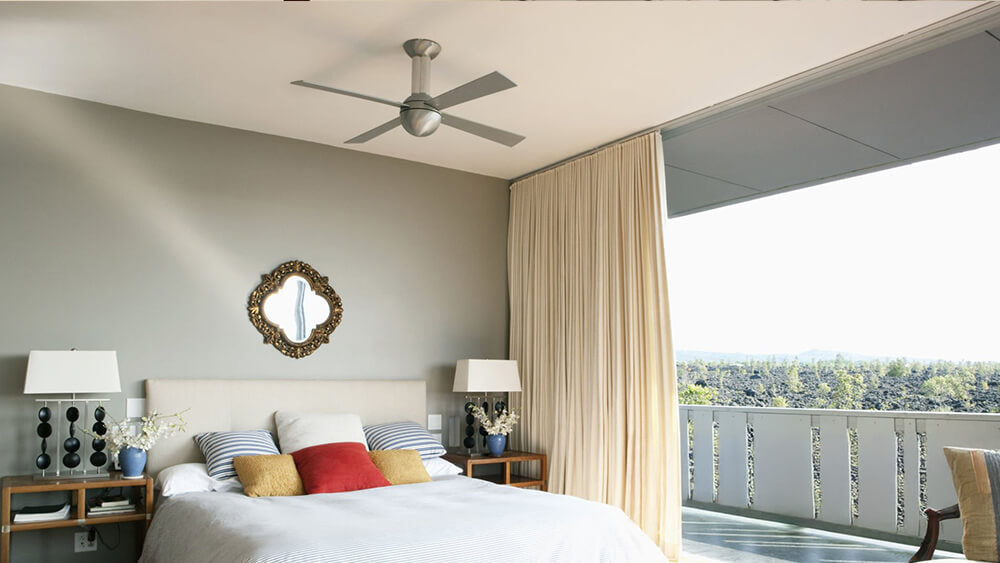Have you ever walked into a building and felt something was not right? Maybe the air felt stale, or a strong gust of wind overwhelmed you. The culprit? Most likely, a ceiling fan that wasn’t properly chosen—either too small to circulate air efficiently or too large, creating excessive airflow.
Want to know what size ceiling fan you need? Our expert guide will help you choose the perfect fan for any room, ensuring maximum comfort and energy efficiency.
What Size Ceiling Fan Do I Need?
The following are the best fan sizing for different-sized rooms:
|
Room Size (sq. ft.) |
Recommended Fan Size |
|
Up to 100 sq. ft. |
29-36 inches |
|
100-200 sq. ft. |
36-42 inches |
|
200-400 sq. ft. |
44-50 inches |
|
400+ sq. ft. |
52-72 inches |
Small Rooms (100-200 sq. ft.)
Ceiling fans in the 36-42-inch range are excellent for bedrooms, home offices, or small kitchens with congenial coolness. If you want the added convenience of lighting, the ComiLED ceiling fan with light is a great choice—it keeps your space cool and well-lit without taking up too much room.
Medium Rooms (200-400 sq. ft.)
Living rooms and dining areas need a fan size of 44 to 50 inches to circulate air effectively without overpowering the room.
Large Rooms (400+ sq. ft.)
Open-concept areas, great rooms, and large master bedrooms need fans sized from 52 to 72 inches for optimum cooling. Consider a fan or two for extra-large spaces. Using the right sizes ensures comfort, energy efficiency, and better air circulation throughout the year.
Why Choosing the Right Ceiling Fan Size Matters?

Choosing the right ceiling fan size will not only provide you with optimal comfort, but it will also ensure proper airflow in your space. If the ceiling fan is too small or too large for the space, it will also lead to insufficient airflow and increased energy costs.
Energy Efficiency & Saving Money
- The USA Department of Energy states that an Energy Star rated fan with the right ceiling fan size can reduce cooling costs up to 40% in summer.
- An adequately sized fan allows you to raise your thermostat 4°F while remaining comfortable so that energy consumption is reduced.
Air Circulation and Comfort
Well-placed fans eliminate hot and cold spots in rooms, providing even airflow throughout the space.. A ceiling fan with light can be particularly useful in states with hot climates, like Florida or Texas, by reducing the need for air conditioning and helping your HVAC system run more efficiently.
Aesthetic and Functional Balance
Oversized fans can overwhelm small bedrooms, while tiny fans in large rooms fail to circulate air effectively. A well-fitted fan enhances both décor and airflow, making rooms more comfortable year-round.
Selecting the appropriate ceiling fan ensures optimal performance and cost-effectiveness without compromising your home's beauty. With proper ventilation, ceiling fans are among the best-known options on the market, offering efficient airflow while consuming less electricity. Want to learn more about achieving the perfect balance? Check out our guide on how to balance your ceiling fan?
How to Determine the Right Size of Ceiling Fan?

Air circulation, energy efficiency, and comfort in a room depend on the primary influence of a fan's size. The ultimate determination can be made based on factors such as the total dimensions of the room, ceiling height, and the blade span of the ceiling fan.
1. Room Size and Square Footage
The ceiling fan size should match the room's dimensions to ensure effective air circulation. For example, what size ceiling fan for the bedroom? A 36-42 inch fan works well for smaller bedrooms, while living rooms typically require fans of 52 inches or larger.
2. Ceiling Height
For standard ceilings at 8 feet, it is best to use flush-mount ceiling fans, whereas taller ceilings require the use of downrods to provide effective airflow. A ceiling over 10 feet may need some larger ceiling fan sizes to push air effectively.
3. Blade Pitch & Number of Blades
A steeper blade pitch (12–15 degrees) moves more air, enhancing cooling. More blades create quieter operation but slightly reduce air flow compared to 3-blade models.
4. Fan Placement & Clearance
Keep at least 7 feet of clearance from the floor for safety. Ensure a minimum of 18 inches between the blade and walls for optimal performance.
How to Calculate the Correct Size for Your Room?
It is important to accurately size a room for a few reasons, including the ceiling fan that would be appropriate, air circulation, and the energy efficiency. Here is a step-by-step guide to help along the way:
1. Calculate the Area
-
For rectangular or square rooms:
Area = Length × Width
-
For L-shaped or any kind of irregular rooms:
Break it down into smaller sections, compute each one of the smaller ones, and then combine all.
2. Measure the Room Dimensions
Using the tape measure in feet, measure the length and width of the room.
-
Example: If the room were 12 feet long and 10 feet wide, the area would be computed as follows:
-
12 × 10 = 120 sq. ft.
3. Determine the Recommended Fan Size
Ceiling fans are measured by their blade span (the diameter of the fan when the blades are fully extended).
Here’s a guide based on room size:
|
Room Size (sq. ft.) |
Fan Blade Span (inches) |
|
Less than 75 sq. ft. |
29" - 36" |
|
76 - 144 sq. ft. |
36" - 42" |
|
145 - 225 sq. ft. |
44" - 50" |
|
226 - 400 sq. ft. |
52" - 60" |
|
More than 400 sq. ft. |
Multiple fans or 60"+ |
Measure Ceiling Height
You would require a normal downrod (3 - 5 inches). High Ceiling (10 and above): Prescribe a longer downrod (12 inches or longer). Low Ceiling: Use flush mount (hugger fan).
- Standard Ceiling (8—9 feet): Use a standard (3—5 inches).
- High Ceiling(10+ feet): Use a longer downrod (12 inches or more).
- Low Ceiling: Opt for a flush mount (hugger fan)
Placement Tips
- The fan should be at least 7 feet above the floor.
- Leave 18–24 inches of clearance from walls.
- For large rooms, consider multiple fans for better airflow.
Formula to Calculate Fan Size
You can use this simple formula:

What Happens if the Ceiling Fan is Too Small or Too Large?

Incorrect choice of ceiling fan size, meaning a fan that is too little will not circulate enough air, will make the room stuffy. If the fan is too big, it might create too much breeze and thus discomfort. Good size is certainly the correct ceiling fan that gives the room good ventilation, leads to good energy efficiency, and makes the room comfortable.
To maintain optimum airflow, choose a recommended fan size based on the room's size and square footage. Getting the right fan size does make a cooler effect, saves on energy costs, or improves comfort overall. Always consider room dimensions against the size of a fan for top performance. Follow a size guide for a perfect fit!
How to Choose the Right Ceiling Fan Size?

There are several steps you should follow that ensure you achieve optimal airflow, energy efficiency, and comfort conditions, sizing the fan:
- Start with evaluating the size of a room: Calculate the square footage (Length × Width).
- Utilize a Fan Size Chart: Match the size of your room with the lower and upper boundaries of the device dimensions listed in:
|
Room Size (sq. ft.) |
Fan Blade Span (inches) |
|
Less than 75 sq. ft. |
29" - 36" |
|
76 - 144 sq. ft. |
36" - 42" |
|
145 - 225 sq. ft. |
44" - 50" |
|
226 - 400 sq. ft. |
52" - 60" |
|
More than 400 sq. ft. |
Multiple fans or 60"+ |
- Define Ceiling Height: For the high ceilings, use the downrod while the flush mount is rather applicable in low ceilings.
- Blade Pitch and Motor Power: Include a fan of large blade pitch and a powerful motor to increase the airflow.
In summary, a well-sized ceiling fan, such as a ceiling fan with light from ComiLED, ensures comfort, energy efficiency, and optimal airflow throughout the year.
Conclusion
A ceiling fan of the correct size ensures the best airflow, energy efficiency, and comfort possible. Too small a fan can hardly move any air at all, while one that is oversized may indeed produce excessive drafts. Getting an ideal fit right is a sure recipe for good ventilation. By following the recommended size guidelines and matching a fan to the room, one can have its share of value.
Still not sure? Contact our experts for a personalized recommendation on the perfect ceiling fan size!
Related reading: What is an Optimal SMF Reading Light Level?






Share:
What Can Cause Room Light to Flicker?
How to Wire a Ceiling Fan with Light?